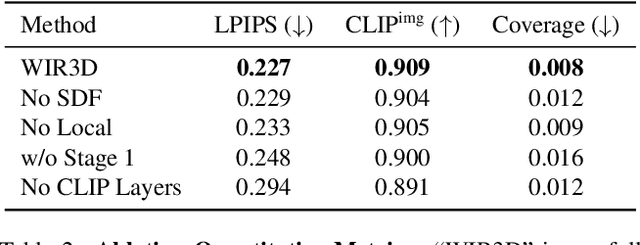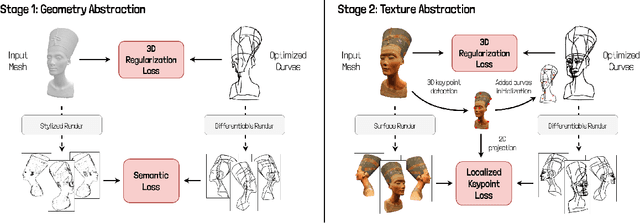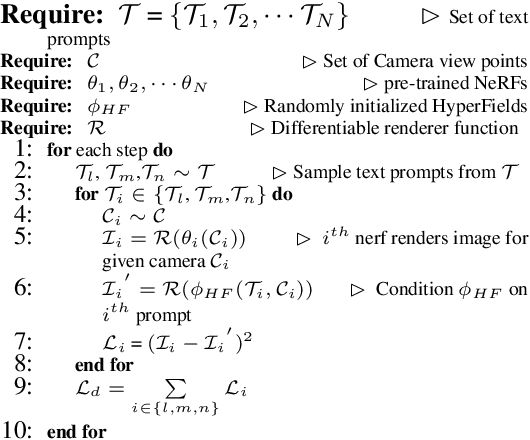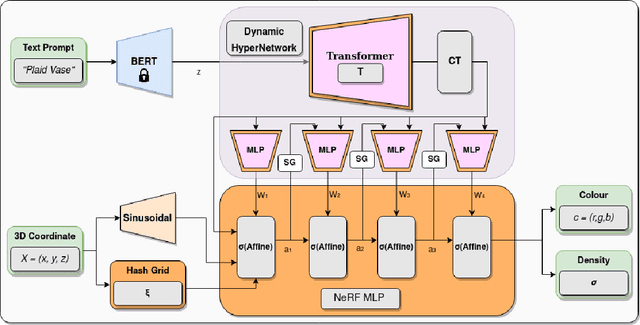Rana Hanocka
Reusing Computation in Text-to-Image Diffusion for Efficient Generation of Image Sets
Aug 28, 2025Abstract:Text-to-image diffusion models enable high-quality image generation but are computationally expensive. While prior work optimizes per-inference efficiency, we explore an orthogonal approach: reducing redundancy across correlated prompts. Our method leverages the coarse-to-fine nature of diffusion models, where early denoising steps capture shared structures among similar prompts. We propose a training-free approach that clusters prompts based on semantic similarity and shares computation in early diffusion steps. Experiments show that for models trained conditioned on image embeddings, our approach significantly reduces compute cost while improving image quality. By leveraging UnClip's text-to-image prior, we enhance diffusion step allocation for greater efficiency. Our method seamlessly integrates with existing pipelines, scales with prompt sets, and reduces the environmental and financial burden of large-scale text-to-image generation. Project page: https://ddecatur.github.io/hierarchical-diffusion/
LL3M: Large Language 3D Modelers
Aug 11, 2025Abstract:We present LL3M, a multi-agent system that leverages pretrained large language models (LLMs) to generate 3D assets by writing interpretable Python code in Blender. We break away from the typical generative approach that learns from a collection of 3D data. Instead, we reformulate shape generation as a code-writing task, enabling greater modularity, editability, and integration with artist workflows. Given a text prompt, LL3M coordinates a team of specialized LLM agents to plan, retrieve, write, debug, and refine Blender scripts that generate and edit geometry and appearance. The generated code works as a high-level, interpretable, human-readable, well-documented representation of scenes and objects, making full use of sophisticated Blender constructs (e.g. B-meshes, geometry modifiers, shader nodes) for diverse, unconstrained shapes, materials, and scenes. This code presents many avenues for further agent and human editing and experimentation via code tweaks or procedural parameters. This medium naturally enables a co-creative loop in our system: agents can automatically self-critique using code and visuals, while iterative user instructions provide an intuitive way to refine assets. A shared code context across agents enables awareness of previous attempts, and a retrieval-augmented generation knowledge base built from Blender API documentation, BlenderRAG, equips agents with examples, types, and functions empowering advanced modeling operations and code correctness. We demonstrate the effectiveness of LL3M across diverse shape categories, style and material edits, and user-driven refinements. Our experiments showcase the power of code as a generative and interpretable medium for 3D asset creation. Our project page is at https://threedle.github.io/ll3m.
WIR3D: Visually-Informed and Geometry-Aware 3D Shape Abstraction
May 07, 2025



Abstract:We present WIR3D, a technique for abstracting 3D shapes through a sparse set of visually meaningful curves in 3D. We optimize the parameters of Bezier curves such that they faithfully represent both the geometry and salient visual features (e.g. texture) of the shape from arbitrary viewpoints. We leverage the intermediate activations of a pre-trained foundation model (CLIP) to guide our optimization process. We divide our optimization into two phases: one for capturing the coarse geometry of the shape, and the other for representing fine-grained features. Our second phase supervision is spatially guided by a novel localized keypoint loss. This spatial guidance enables user control over abstracted features. We ensure fidelity to the original surface through a neural SDF loss, which allows the curves to be used as intuitive deformation handles. We successfully apply our method for shape abstraction over a broad dataset of shapes with varying complexity, geometric structure, and texture, and demonstrate downstream applications for feature control and shape deformation.
Geometry in Style: 3D Stylization via Surface Normal Deformation
Mar 29, 2025Abstract:We present Geometry in Style, a new method for identity-preserving mesh stylization. Existing techniques either adhere to the original shape through overly restrictive deformations such as bump maps or significantly modify the input shape using expressive deformations that may introduce artifacts or alter the identity of the source shape. In contrast, we represent a deformation of a triangle mesh as a target normal vector for each vertex neighborhood. The deformations we recover from target normals are expressive enough to enable detailed stylizations yet restrictive enough to preserve the shape's identity. We achieve such deformations using our novel differentiable As-Rigid-As-Possible (dARAP) layer, a neural-network-ready adaptation of the classical ARAP algorithm which we use to solve for per-vertex rotations and deformed vertices. As a differentiable layer, dARAP is paired with a visual loss from a text-to-image model to drive deformations toward style prompts, altogether giving us Geometry in Style. Our project page is at https://threedle.github.io/geometry-in-style.
MeshUp: Multi-Target Mesh Deformation via Blended Score Distillation
Aug 27, 2024Abstract:We propose MeshUp, a technique that deforms a 3D mesh towards multiple target concepts, and intuitively controls the region where each concept is expressed. Conveniently, the concepts can be defined as either text queries, e.g., "a dog" and "a turtle," or inspirational images, and the local regions can be selected as any number of vertices on the mesh. We can effectively control the influence of the concepts and mix them together using a novel score distillation approach, referred to as the Blended Score Distillation (BSD). BSD operates on each attention layer of the denoising U-Net of a diffusion model as it extracts and injects the per-objective activations into a unified denoising pipeline from which the deformation gradients are calculated. To localize the expression of these activations, we create a probabilistic Region of Interest (ROI) map on the surface of the mesh, and turn it into 3D-consistent masks that we use to control the expression of these activations. We demonstrate the effectiveness of BSD empirically and show that it can deform various meshes towards multiple objectives.
Generative Lifting of Multiview to 3D from Unknown Pose: Wrapping NeRF inside Diffusion
Jun 11, 2024Abstract:We cast multiview reconstruction from unknown pose as a generative modeling problem. From a collection of unannotated 2D images of a scene, our approach simultaneously learns both a network to predict camera pose from 2D image input, as well as the parameters of a Neural Radiance Field (NeRF) for the 3D scene. To drive learning, we wrap both the pose prediction network and NeRF inside a Denoising Diffusion Probabilistic Model (DDPM) and train the system via the standard denoising objective. Our framework requires the system accomplish the task of denoising an input 2D image by predicting its pose and rendering the NeRF from that pose. Learning to denoise thus forces the system to concurrently learn the underlying 3D NeRF representation and a mapping from images to camera extrinsic parameters. To facilitate the latter, we design a custom network architecture to represent pose as a distribution, granting implicit capacity for discovering view correspondences when trained end-to-end for denoising alone. This technique allows our system to successfully build NeRFs, without pose knowledge, for challenging scenes where competing methods fail. At the conclusion of training, our learned NeRF can be extracted and used as a 3D scene model; our full system can be used to sample novel camera poses and generate novel-view images.
iSeg: Interactive 3D Segmentation via Interactive Attention
Apr 04, 2024Abstract:We present iSeg, a new interactive technique for segmenting 3D shapes. Previous works have focused mainly on leveraging pre-trained 2D foundation models for 3D segmentation based on text. However, text may be insufficient for accurately describing fine-grained spatial segmentations. Moreover, achieving a consistent 3D segmentation using a 2D model is challenging since occluded areas of the same semantic region may not be visible together from any 2D view. Thus, we design a segmentation method conditioned on fine user clicks, which operates entirely in 3D. Our system accepts user clicks directly on the shape's surface, indicating the inclusion or exclusion of regions from the desired shape partition. To accommodate various click settings, we propose a novel interactive attention module capable of processing different numbers and types of clicks, enabling the training of a single unified interactive segmentation model. We apply iSeg to a myriad of shapes from different domains, demonstrating its versatility and faithfulness to the user's specifications. Our project page is at https://threedle.github.io/iSeg/.
AmbiGen: Generating Ambigrams from Pre-trained Diffusion Model
Dec 05, 2023Abstract:Ambigrams are calligraphic designs that have different meanings depending on the viewing orientation. Creating ambigrams is a challenging task even for skilled artists, as it requires maintaining the meaning under two different viewpoints at the same time. In this work, we propose to generate ambigrams by distilling a large-scale vision and language diffusion model, namely DeepFloyd IF, to optimize the letters' outline for legibility in the two viewing orientations. Empirically, we demonstrate that our approach outperforms existing ambigram generation methods. On the 500 most common words in English, our method achieves more than an 11.6% increase in word accuracy and at least a 41.9% reduction in edit distance.
3D Paintbrush: Local Stylization of 3D Shapes with Cascaded Score Distillation
Nov 16, 2023Abstract:In this work we develop 3D Paintbrush, a technique for automatically texturing local semantic regions on meshes via text descriptions. Our method is designed to operate directly on meshes, producing texture maps which seamlessly integrate into standard graphics pipelines. We opt to simultaneously produce a localization map (to specify the edit region) and a texture map which conforms to it. This synergistic approach improves the quality of both the localization and the stylization. To enhance the details and resolution of the textured area, we leverage multiple stages of a cascaded diffusion model to supervise our local editing technique with generative priors learned from images at different resolutions. Our technique, referred to as Cascaded Score Distillation (CSD), simultaneously distills scores at multiple resolutions in a cascaded fashion, enabling control over both the granularity and global understanding of the supervision. We demonstrate the effectiveness of 3D Paintbrush to locally texture a variety of shapes within different semantic regions. Project page: https://threedle.github.io/3d-paintbrush
HyperFields: Towards Zero-Shot Generation of NeRFs from Text
Oct 27, 2023



Abstract:We introduce HyperFields, a method for generating text-conditioned Neural Radiance Fields (NeRFs) with a single forward pass and (optionally) some fine-tuning. Key to our approach are: (i) a dynamic hypernetwork, which learns a smooth mapping from text token embeddings to the space of NeRFs; (ii) NeRF distillation training, which distills scenes encoded in individual NeRFs into one dynamic hypernetwork. These techniques enable a single network to fit over a hundred unique scenes. We further demonstrate that HyperFields learns a more general map between text and NeRFs, and consequently is capable of predicting novel in-distribution and out-of-distribution scenes -- either zero-shot or with a few finetuning steps. Finetuning HyperFields benefits from accelerated convergence thanks to the learned general map, and is capable of synthesizing novel scenes 5 to 10 times faster than existing neural optimization-based methods. Our ablation experiments show that both the dynamic architecture and NeRF distillation are critical to the expressivity of HyperFields.
 Add to Chrome
Add to Chrome Add to Firefox
Add to Firefox Add to Edge
Add to Edge